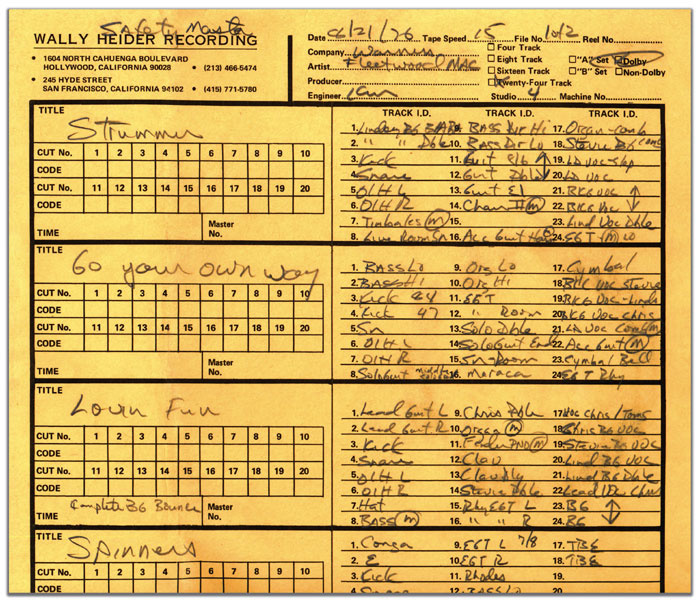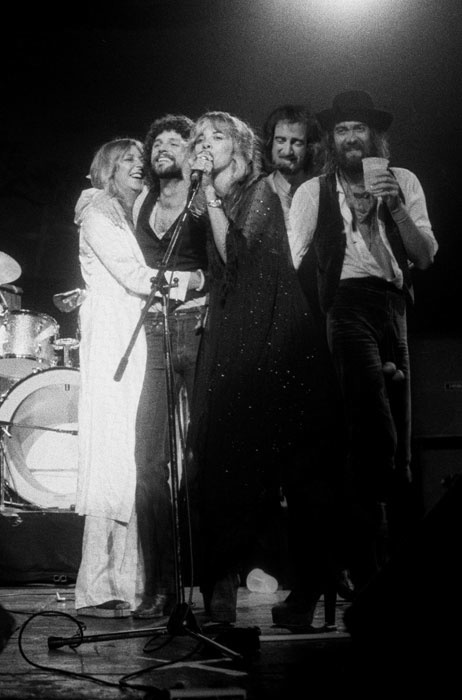
Welcome back to our new series on Flypaper, Album Histories Monthly, which brings you the story of a single album each month, in the month that it was originally released. Last month, we covered The Buggles’ Age of Plastic. This month:
Fleetwood Mac – Rumours
Release Date: February 4, 1977
“When we started Rumours in early 1976, we were all in an emotional ditch. Everybody knew everything about everybody. But I was the piggy in the middle because I had less trauma than the others.” – Mick Fleetwood (drummer)
Rumours is one of the most deservedly beloved albums of all time. Filled from start to finish with amazing songs that are honest, beautiful, and filled with resonant emotion, the album is a product of Fleetwood Mac’s immense talent and work ethic as a band smashing against their crumbling interpersonal relationships via affairs, lies, and a whole lot of drugs.
The Rumours recording session is one of the most talked about studio moments of all time. The crushing decay of the band’s relationships with each other can be felt and heard in the songs, giving listeners an acute feeling of what the band was going through. Rumours is genius meets heartbreak, and every second of it is riveting.
The fact that you can hear these relationships falling apart through the music is, perhaps, one of the reasons the album is so popular so many years later. Like a burning car wreck on the highway, we cannot look away. Let’s begin by examining bassist John and keyboardist Christine McVie’s failing marriage.
Christine described the situation in a 1977 interview with Rolling Stone journalist Cameron Crowe:
“We were very happy. Very happy for probably three years and then the strain of me being in the same band as him started to take its toll. When you’re in the same band as somebody, you’re seeing them almost more than 24 hours a day. You start to see an awful lot of the bad side ’cause touring is no easy thing. There’s a lot of drinking… John is not the most pleasant of people when he’s drunk. Very belligerent. I was seeing more Hyde than Jekyll.”
Drummer, Mick Fleetwood was also going through a separation with his wife (who he’d recently found out was having an affair with his best friend) during the recording of Rumours, while Stevie Nicks and her erstwhile partner guitarist and vocalist, Lindsey Buckingham were going through their own drawn out break up. Nicks describes the reasons for her breakup with Buckingham thusly:
“The best explanation is: try working with your secretary… in a raucous office… and then come home with her at night. See how long you could stand her. I could be no comfort to Lindsey when he needed comfort.”
Nicks had trouble balancing their professional and personal lives:
“So we’d go back to where we were staying and he would really need comfort from me, for me to say, ‘It’s all right. Who cares about them?’ You know, be [his] old lady,” said Nicks in 1977, “I was also pissed off because he hadn’t gotten the guitar part on. So I’m trying to defend [the band’s] point of view and at the same time trying to make him feel better. It doesn’t work. I couldn’t be all those things.”
The fractures that were lurking under the surface all around the members of the band deepened when their eponymous 1975 album propelled the band to new heights. It was under this unbelievable pressure, with schisms that were slowly tearing the band apart, that they recorded their masterpiece.
“When are the two chemicals going to mix? When are we going to have the explosion?” – Ken Caillat (producer)
Rumours is full of lyrical jabs thrown from one band member to another.
On “Go Your Own Way,” Buckingham uses his verse to alert Nicks that “loving you isn’t the right thing to do,” and “packing up, shacking up is all you wanna do.” Nicks heavily objected to that last line appearing in the final mix of the song, but Buckingham refused to remove it and somehow won the battle for keeping it in. Perhaps this helps to indicate why she joined him enthusiastically to sing “you can go your own way” in the chorus!
It’s not abnormal that Nicks didn’t want Buckingham “telling the world that ‘packing up, shacking up’ with different men was all I wanted to do.” Buckingham is singing this song directly to Nicks. So many of the lyrics on this album are intensely personal and intimate; It must have been incredibly painful and hurtful to sing them with and to the people they were about.
I mean, maybe times have changed, or maybe it was the cocaine-heavy diet they were all on, but with two intra-band relationships falling apart and the only non-romantically involved partner also losing his marriage, it’s hard to imagine how they actually brought themselves to finish the record.

On “Second Hand News”, Buckingham is both saying that he “ain’t going to miss you when you go,” and asking, almost pleading, with Nicks to “lay me down in the tall grass and let me do my stuff.” Their emotions were raw.
Also, why is there a pair of wooden balls hanging down from Mick Fleetwood’s waste in the classic Herbert Worthington photograph that became the album cover? Apparently it’s a story that goes way back to one of the band’s first ever gigs.
In the early years, Fleetwood’s drinking habit made him a bit reckless and destructive. At one of their gigs, he found the balls dangling from a lavatory chain in the toilet and yanked them off, walking back into the bar with them hanging down from his waste. This sense of humor was essential to the band’s persona, as well as their ability to cope with all the obstacles they faced, and it’s why the balls appeared on the cover.
But why they’re still around today, traveling with Fleetwood wherever he performs, is another story. Over the years, they’ve become a good luck charm. Even though the original pair were lost on the road years ago, replicas were made and retain the same importance for him.

Anyway, back to the album. Rumours is a dialogue between five people all going through emotional turmoil. Fuelled by massive amounts of drugs, the entire band seem to be unyielding in their willingness to force each other to hear their deepest truths. Their honesty came out in the songwriting, it had to.
Recording engineers Ken Caillat and Richard Dashut were concerned if the band would even be able to complete the record under all this personal strain. Caillat said that Christine would “sneak her new boyfriend into the studio just as John was walking out through another door, and we were kinda ducking — ‘When are the two chemicals going to mix? When are we going to have the explosion?”
Calliat also remembered:
“Lindsey and Stevie were still in the fighting stage. I remember them singing background vocals to ‘You Make Loving Fun,’ sitting on two stools in front of a pair of microphones, directly facing me on the other side of the control room glass, and if we had to stop tape for whatever reason, during the few seconds that it was being rewound they’d be shouting and screaming at one another.”
Even while the members of the band were feuding with each other, they were able to set aside their differences to work together and collaborate. On “Don’t Stop,” Christine McVey, Buckingham, and Caillat had to rearrange some of the instrumentation in the mixing phase, so as to move around some of the more similar frequencies.
He was having trouble hearing the guitar and keyboard parts as separate from each other since they were playing in the same register. McVey moved her part down a third to get out of Buckingham’s way, and it worked out brilliantly. After that she would naturally look out to make sure instruments weren’t clashing, and recompose parts on the spot in order to make it easier on the engineers’ mixing process.
Despite their personal issues the music always came first. And in this way, Caillat also became sort of a band/relationship coach in order to make sure everyone was playing nice.
The culmination of members working together came when all five members collaborated equally on the song “The Chain” together. This is the only song on the record that lists all of the members as co-writers. It starts the B-side, thus creating a bridge between both sides of the album, or in other words, a chain.
“The Chain” almost pays homage to previous songs the band had worked on together. It begins on a much darker note than the other songs on the album, with a guitar lick recycled from the song “Lola My Love” off Buckingham and Nicks’ self-titled album, and the bass riff in the middle comes from a previously discarded Christine McVie song called “Keep Me There.”
“It’s an album that simply exists outside of criticism and outside of its time, even if it thoroughly captures its era. “ – Stephen Thomas Erlewine (critic)
The original demo of the song began with Nicks describing her frustrations with Buckingham. She sings, “slipped into the fountains of my emptiness, I let teardrops fall, I let them go. Stepped into the canyons of my loneliness, and I went about as far as I could go.”
The lyrics in the final version of the song are much more vague, but convey the same frustration. You can hear it in her voice when she sings, “listen to the wind blow, watch the sunrise. Running in the shadows, damn your love, damn your lies.” Nicks is tired of living her life in the shadow of a failed relationship and is frustrated with all of it, the good and the bad.
The chorus explains where this frustration is coming from. Nicks sings “and if you don’t love me now, you will never love me again, I can still hear you saying, you will never break the chain.” She’s rightfully angry that Buckingham has broken the chain of their love. Their romantic relationship has deteriorated to a place beyond repair, while their professional relationship is reaching new heights.

This juxtaposition of forces is creating an untenable tension in their lives which is reflected in the emotive power of the music. It’s a very human thing to be pulled by someone in two directions, to feel pain and helplessness as the contours of your relationship change.
Then at around 3:30 in “The Chain,” the song erupts into a furious guitar solo reflecting the anger and frustration the band felt about each other. The final lyrics of the song are much angrier and frustrated than the rest, it’s almost as if the song has exploded into an argument itself, further reinforcing all these issues in plain sight.
Even though every member of the band was more than capable and confident, they had an open dialogue with their producers Caillat and Dashut.
“At first, I was only going to engineer,” Caillat says. “However, the group’s attitude was, ‘Hey, you can’t sit in there and just turn knobs, kid. You’ve got to tell us what’s going on. You need to be our eyes and ears.’ After we’d done a couple of takes, I was asked which one I liked best. I was looking at them like, ‘Well, why don’t you just come in and listen?’ The fact was, they didn’t want to come in. They wanted input from the control room. So, when they then asked if I liked one bass part more than another bass part, I spoke up, and it was the same with Richard. He and I quickly figured out this wasn’t going to be just a ‘sit back and turn the knobs’ gig. We’d have to pay attention and maybe take notes once in a while, and soon we were telling them, ‘Hey, that was a great take. We really like that second take more.’ It was kinda like Producing 101.”
When Rumours hit the shelves, the album was a smash hit. This should come as no surprise to music fans today, as these songs have become ubiquitous and classic, still playing on radio stations nationally every single day. It was named 1977’s Album Of The Year by the Grammys. Rock journalist, Cameron Crowe wrote in Rolling Stone that:
“Fleetwood Mac’s music has evolved into a sophisticated pop and rock sound that’s just right for the Seventies, thanks primarily to two women, old-timer Christine McVie and newcomer Stevie Nicks.”
These songs have been played at colleges and in bars around the country for four decades and it seems like they will be played for at least another four. Nicks also acknowledged during an episode of VH1’s Behind The Music that “devastation leads to writing good things.” But perhaps, AllMusic’s Stephen Thomas Erlewine says it best:
“Rumours is the kind of album that transcends its origins and reputation, entering the realm of legend — it’s an album that simply exists outside of criticism and outside of its time, even if it thoroughly captures its era.”
Interested in learning about pro-audio mixing techniques? Preview our new course series, Faders Up I & II: Modern Mix Techniques and Advanced Mix Techniques, which combine tips and perspectives from nine of today’s top sound engineers along with professional mentorship on your work for six weeks from a Soundfly Mentor, for free today!
Sign up before March 6, take 30% off (that’s $150) any of our courses with the promo code LASTCHANCE.
—
Bibliography
Buskin, Richard. “Fleetwood Mac ‘Go Your Own Way’.” Sound on Sound, August, 2007. Web.
Crowe, Cameron. “The True Life Confessions of Fleetwood Mac.” Rolling Stone, Rolling Stone, 24 March, 1977. Web.
Herbst, Peter. “Fleetwood Mac Not Hurt By Stevie Nicks.” Rolling Stone, Rolling Stone, 25 August, 1977. Web.
Marsh, Dave. “Big (Fleetwood) Mac: The 1978 Cover Story.” Rolling Stone, Rolling Stone, 12 Jan. 1978, www.rollingstone.com/music/news/big-fleetwood-mac-the-1978-cover-story-19780112.
Polyphonic. “How Fleetwood Mac Wrote ‘The Chain.’” YouTube, Polyphonic, 5 Oct. 2017. Web.
Runtagh, Jordan. “Fleetwood Mac’s ‘Rumours’: 10 Things You Didn’t Know.” Rolling Stone, Rolling Stone, 3 February, 2017. Web.




